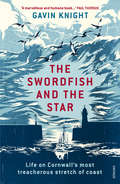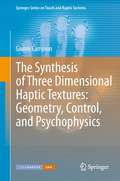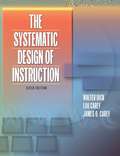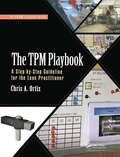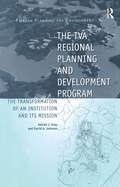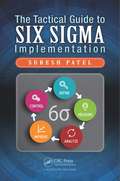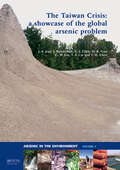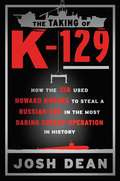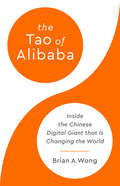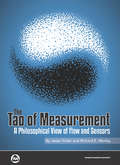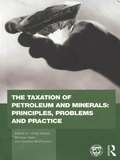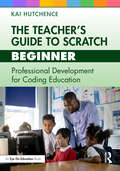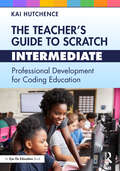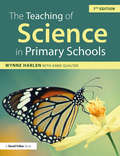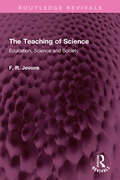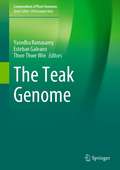- Table View
- List View
The Switch: An Off and On History of Digital Humans
by Jason PuskarFrom the telegraph to the touchscreen, how the development of binary switching transformed everyday life and changed the shape of human agency The Switch traces the sudden rise of a technology that has transformed everyday life for billions of people: the binary switch. By chronicling the rapid growth of binary switching since the mid-nineteenth century, Jason Puskar contends that there is no human activity as common today as pushing a button or flipping a switch—the deceptively simple act of turning something on or off. More than a technical history, The Switch offers a cultural and political analysis of how reducing so much human action to binary alternatives has profoundly reshaped modern society. Analyzing this history, Puskar charts the rapid shift from analog to digital across a range of devices—keyboards, cameras, guns, light switches, computers, game controls, even the &“nuclear button&”—to understand how nineteenth-century techniques continue to influence today&’s pervasive digital technologies. In contexts that include musical performance, finger counting, machine writing, voting methods, and immersive play, Puskar shows how the switch to switching led to radically new forms of action and thought. The innovative analysis in The Switch makes clear that binary inputs have altered human agency by making choice instantaneous, effort minimal, and effects more far-reaching than ever. In the process, it concludes, switching also fosters forms of individualism that, though empowering for many, also preserve a legacy of inequality and even domination.
The Swordfish and the Star: Life on Cornwall's most treacherous stretch of coast
by Gavin KnightThe Penwith Peninsula in Cornwall is where the land ends. In The Swordfish and the Star Gavin Knight takes us into this huddle of grey roofs at the edge of the sea at the beginning of the twenty-first century. He catches the stories of a whole community, but especially those still working this last frontier: the Cornish fishermen. These are the dreamers and fighters who every day prepare for battle with the vast grey Atlantic. Cornwall and its seas are brought to life, mixing drinking and drugs and sea spray, moonlit beaches and shattering storms, myth and urban myth. The result is an arresting tapestry of a place we thought we knew; the precarious reality of life in Cornwall today emerges from behind our idyllic holiday snaps and picture postcards. Even the quaint fishermen’s pubs on the quay at Newlyn, including the Swordfish and its neighbour the Star, turn out to be places where squalls can blow up, and down again, in an instant. Based on immersive research and rich with the voices of a cast of remarkable characters, this is an eye-opening, dramatic, poignant account of life on Britain’s most dangerous stretch of coast.Praise for Hood Rat 'A gripping novelistic immersion' Louis Theroux'A must-read' Owen Jones'Britain's Gomorrah' Independent
The Synthesis of Three Dimensional Haptic Textures: Geometry, Control, and Psychophysics
by Gianni CampionThe sense of touch is fundamental during the interaction between humans and their environment; in virtual reality, objects are created by computer simulations and they can be experienced through haptic devices. In this context haptic textures are fundamental for a realistic haptic perception of virtual objects.This book formalizes the specific artefacts corrupting the rendering of virtual haptic textures and offers a set of simple conditions to guide haptic researchers towards artefact-free textures. The conditions identified are also extremely valuable when designing psychophysical experiments and when analyzing the significance of the data collected. The Synthesis of Three Dimensional Haptic Textures, Geometry, Control, and Psychophysics examines the problem of rendering virtual haptic textures with force feedback devices. The author provides an introduction to the topic of haptic textures that covers the basics of the physiology of the skin, the psychophysics of roughness perception, and the engineering challenges behind haptic textures rendering. The book continues with the presentation of a novel mathematical framework that characterizes haptic devices, texturing algorithms and their ability to generate realistic haptic textures. Finally, two psychophysical experiments link the perception of roughness with the parameters of the haptic rendering algorithms. This book formalizes the specific artefacts corrupting the rendering of virtual haptic textures and offers a set of simple conditions to guide haptic researchers towards artefact-free textures. The conditions identified are also extremely valuable when designing psychophysical experiments and when analyzing the significance of the data collected.
The Systematic Design of Instruction (Sixth Edition)
by Walter O. Dick Lou Carey James O. CareyThis classic text introduces students to the fundamentals of instructional design and helps them learn the concepts and procedures for designing, developing, and evaluating instruction for all delivery formats. The new edition builds upon the foundation of previous editions with clear discussions on the impact of critical new theories, new technologies, and the Internet. The book addresses current design processes used in instructional settings and delivery systems across many areas of curriculum and business, including Internet-based Distance Education. Hallmark Features *The text clearly describes and models the instructional design process as it is practiced in educational and business settings, allowing students easy transfer of important topics. *The conceptual base for each step in the instructional design model is clearly defined and described in an accessible manner.*Application of and decision-making about instructional design concepts are illustrated through a serial case study example carried through the steps of the design model in each chapter of the book. *Opportunities are provided for readers to apply new concepts through practice and feedback activities at the end of each chapter. *Up-to-date references and recommended readings with annotations allow students to further explore the concepts presented in the text. *This new edition uses course management technology to illustrate design. The new CourseCompass website includes: goals and objectives for each step in the model, illustrations of preinstructional materials, rubrics for evaluating products for each step in the model, concept quizzes, and much more.
The TPM Playbook: A Step-by-Step Guideline for the Lean Practitioner (The\lean Playbook Ser.)
by Chris A. OrtizThis book is a guideline for implementation and it is intended for the Lean practitioner looking for a training tool and a guideline that can be used in the work area while improvements are being conducted. It describes how to effectively implement total productive maintenance.
The TVA Regional Planning and Development Program: The Transformation of an Institution and Its Mission (Urban Planning and Environment)
by David A. JohnsonThe Tennessee Valley Authority (TVA) is a world-renowned model for regional planning and development. Based along the Tennessee River and its series of hydro-electric power stations, dams and reservoirs, the TVA development program envisioned a broad regional planning program. The program focused on development opportunities and problems around the array of TVA dams and their reservoirs. It also created new 'model' towns and pioneered land-use planning bringing together federal, state, and local agencies, farmers, foresters and industrial firms to further the economic, social, and physical conditions of what had been one of the most seriously lagging regions of the U.S. This book is based on the memoirs and experiences of Aelred J. Gray, former planner with the TVA, who saw the 'big picture' and introduced much of the pioneering work of the agency. Gray worked as a staff planner at the TVA for nearly 40 years including a decade as its chief planner, overseeing numerous changes and developments to the Authority's program. As well as building up the regional industrial development and the foundation of state parks, he also had a strong interest in the region's cities. In the 1950s he introduced TVA's landmark Flood Prevention Program, which became a national model. His review of how this innovative and influential regional development agency functioned and changed through the decades will be of value to all those interested in planning practice, planning history, and regional politics.
The Tactical Guide to Six Sigma Implementation
by Suresh PatelBooks in the Quality and Business Excellence series can help readers enhance customer value and satisfaction by integrating the customer’s voice into design, manufacturing, supply chain, and field processes. Although there are many Six Sigma books on the market, few clarify the essential aspects of its implementation across various industries. The Tactical Guide to Six Sigma Implementation fills this need.Simplifying a complex subject and removing the intimidation of using statistics, the book takes readers through the five phases of the Six Sigma methodology—Define-Measure-Analyze-Improve-Control (DMAIC). In ten clearly written and easy-to-understand chapters, readers learn the purpose of each phase and what activities must be performed in each phase.The book illustrates the layout of the interaction of organizational processes—defining product and information flows separately such that each process receives product or information and, after completion of the process, supplies the output to the next process.The author identifies organizational processes through turtle and SIPOC diagrams, defining the process owner, inputs and outputs, and process customer for each process. He also explains how to determine the measures and goals of the process, and how to document the process so that further process improvements can be implemented through management reviews.The text presents a comprehensive process control plan assessment to comply with automotive, aerospace, and all types of manufacturing and service processes. It details 17 global quality management system processes covering management responsibility, resource management, product realization policies, and management analysis and improvement policies. It also provides comprehensive root cause analysis and problem solving techniques.Numerous figures, charts, formulae and forms are included throughout the book and all statistics are described to the exact level of understanding required. Books in this series are suitable for use as basic textbooks for Green Belt, Black Belt, BBA, and MBA courses in global quality, Lean Six Sigma, and business excellence.
The Tactile Internet
by Tara Ali-Yahiya Wrya MonnetThe Tactile Internet will change the landscape of communication by introducing a new paradigm that enables the remote delivery of haptic data.This book answers the many questions surrounding the Tactile Internet, including its reference architecture and adapted compression methods for conveying haptic information. It also describes the key enablers for deploying the applications of the Tactile Internet.As an antecedent technology, the IoT is tackled, explaining the differences and similarities between the Tactile Internet, the Internet of Things and the Internet of Everything. The essentials of teleoperation systems are summarized and the challenges that face this paradigm in its implementation and deployment are also discussed.Finally, a teleoperation case study demonstrating an application of the Tactile Internet is investigated to demonstrate its functionalities, architecture and performance.
The Taiwan Crisis: a showcase of the global arsenic problem (Arsenic in the environment)
by Jochen Bundschuh Jiin-Shuh Jean Chien-Jen Chen How-Ran Guo Chen-Wuing Liu Tsair-Fuh Lin Yen-Hua ChenIn the 1950s, the residents of the southwestern coastal areas of Taiwan suffered greatly from Blackfoot disease (BFD) due to the consumption of arsenic-contaminated groundwater. Groundwater with high levels of arsenic in southwestern and northeastern Taiwan received much attention. After arsenic-safe tap water was utilized for drinking instead of g
The Takedown
by Corrie WangKyla Cheng doesn't expect you to like her. For the record, she doesn't need you to. On track to be valedictorian, she's president of her community club, a debate team champ, plus the yummy Mackenzie Rodriguez has firmly attached himself to her hip. She and her three high-powered best friends don't just own their senior year at their exclusive Park Slope, Brooklyn high school, they practically define the hated species Popular. Kyla's even managed to make it through high school completely unscathed. Until someone takes issue with this arrangement. A week before college applications are due, a video of Kyla "doing it" with her crush-worthy English teacher is uploaded to her school's website. It instantly goes viral, but here's the thing: it's not Kyla in the video. With time running out, Kyla delves into a world of hackers, haters and creepy stalkers in an attempt to do the impossible-take something off the internet-all while dealing with the fallout from her own karmic footprint. Set in near-future Brooklyn, where privacy is a bygone luxury and every perfect profile masks damning secrets, The Takedown is a stylish, propulsive, and provocative whodunit, asking who would you rely on if your tech turned against you?
The Taking of K-129: How the CIA Used Howard Hughes to Steal a Russian Sub in the Most Daring Covert Operation in History
by Josh DeanAn incredible true tale of espionage and engineering set at the height of the Cold War—a mix between The Hunt for Red October and Argo—about how the CIA, the U.S. Navy, and America’s most eccentric mogul spent six years and nearly a billion dollars to steal the nuclear-armed Soviet submarine K-129 after it had sunk to the bottom of the Pacific Ocean; all while the Russians were watching.In the early hours of February 25, 1968, a Russian submarine armed with three nuclear ballistic missiles set sail from its base in Siberia on a routine combat patrol to Hawaii. Then it vanished.As the Soviet Navy searched in vain for the lost vessel, a small, highly classified American operation using sophisticated deep-sea spy equipment found it—wrecked on the sea floor at a depth of 16,800 feet, far beyond the capabilities of any salvage that existed. But the potential intelligence assets onboard the ship—the nuclear warheads, battle orders, and cryptological machines—justified going to extreme lengths to find a way to raise the submarine.So began Project Azorian, a top-secret mission that took six years, cost an estimated $800 million, and would become the largest and most daring covert operation in CIA history. After the U.S. Navy declared retrieving the sub “impossible,” the mission fell to the CIA's burgeoning Directorate of Science and Technology, the little-known division responsible for the legendary U-2 and SR-71 Blackbird spy planes. Working with Global Marine Systems, the country's foremost maker of exotic, deep-sea drilling vessels, the CIA commissioned the most expensive ship ever built and told the world that it belonged to the reclusive billionaire Howard Hughes, who would use the mammoth ship to mine rare minerals from the ocean floor. In reality, a complex network of spies, scientists, and politicians attempted a project even crazier than Hughes’s reputation: raising the sub directly under the watchful eyes of the Russians. The Taking of K-129 is a riveting, almost unbelievable true-life tale of military history, engineering genius, and high-stakes spy-craft set during the height of the Cold War, when nuclear annihilation was a constant fear, and the opportunity to gain even the slightest advantage over your enemy was worth massive risk.
The Tall Buildings Reference Book
by Antony Wood Dave ParkerAs the ever-changing skylines of cities all over the world show, tall buildings are an increasingly important solution to accommodating growth more sustainably in today’s urban areas. Whether it is residential, a workplace or mixed use, the tower is both a statement of intent and the defining image for the new global city. The Tall Buildings Reference Book addresses all the issues of building tall, from the procurement stage through the design and construction process to new technologies and the building’s contribution to the urban habitat. A case study section highlights the latest, the most innovative, the greenest and the most inspirational tall buildings being constructed today. A team of over fifty experts in all aspects of building tall have contributed to the making of the Tall Buildings Reference Book, creating an unparalleled source of information and inspiration for architects, engineers and developers.
The Tao of Alibaba: Inside the Chinese Digital Giant That Is Changing the World
by Brian A WongFrom a long-time Alibaba executive and former special assistant to Jack Ma, this is the first book to articulate how Alibaba's unique culture and &“tai chi&” management principles are providing a business and economic development model for the rest of the world. If you took the economic might of Amazon, and added the penetration of Facebook, the ubiquity of Google, and the cultural significance of YouTube, you might have something starting to resemble Alibaba. Commonly mischaracterized as a kind of Chinese eBay for businesses, Alibaba and its interlinked network of products and services have exploded into global markets, disrupting conventional businesses and creating previously unimaginable opportunities for millions of small businesses worldwide. This book reveals the Tao of Alibaba—the company&’s &“secret sauce&”—a consciously cultivated ethos and spirit that has enabled Alibaba to weather tough times and setbacks, and persist toward a common mission. It is a blueprint of the company&’s management philosophy, crystalized into the most important elements that have driven its success, and it provides a road map for how to incorporate these principles into any organization&’s operations. Wong distills his nearly two decades of experience inside the company to show readers how to align their organization&’s capabilities with performance-maximizing tools in order to achieve success. But most importantly, the Tao of Alibaba teaches the pursuit of greater purpose and meaning, steering entrepreneurs to view their ventures as a vehicle for having profound and lasting impacts on their communities. Ultimately, the lessons shared in The Tao of Alibaba will serve as timeless tools for any entrepreneur seeking to configure their organization toward purpose and impact.
The Tao of Measurement: A Philosophical View of Flow and Sensors
by Richard E. Morley Jesse YoderThis book deals with the past, present, and future of flow, sensors, and measurement. It is called The Tao of Measurement because, like the Tao itself, it reveals the underlying principles of flow and measurement. It explains the engineering and physics of flow and sensors, how our units of measurement were derived, present day measurement practices, and how today's scientific tools can improve our units of measurement. It's a must-read for anyone involved in instrumentation or process control. The book's opening chapters explore the technologies of temperature, pressure, and flow measurement. The authors reveal the history of units of measurement and describe how they came to be used today. The book then presents a thorough discussion of the different types of temperature sensors, pressure transmitters, and flowmeters. It contains an explanation of applications, and then comments on trends in sensors and measurement. Each chapter includes a handy glossary of units of measurement. The authors then turn their attention to three very familiar but vital subjects: time, length and area. They trace the origins of today's units of measurement for these variables, all the way back to Greek and Roman times, then follow their development to today's atomic clocks and the standard meter, now defined in terms of wavelengths of light. This book describes how modern technology can be used to improve units of measurement. It paints a picture of a dynamic and changing universe, one in which systems can be integrated with improved measurement practices. It looks beyond the static nature of everyday objects to an underlying reality that is dynamic and changing. It describes the technologies that are available to effectively configure a cost-effective system, and then shows how to integrate this system with the most powerful sensors and tools of flow measurement. Systems and instrumentation, the yin and yang of the automation world, are finally united in a synthesis that comes from seeing both from a single perspective. The Tao of measurement is revealed, and in the end, it is all about flow.
The Tapper Twins Go Viral (The Tapper Twins #4)
by Geoff RodkeyTold as a series of interviews, photos, texts, social media hits, and videogame screenshots, The Tapper Twins Go Viral is a laugh-a-page book with a serious lesson: never feed the internet trolls! Claudia Tapper just doesn't get it: How is it possible that the video of the best breakup song she's ever written is watched by virtually nobody, when her brother Reese's completely moronic 2-second clip of an video game wipeout ends up being the hottest thing online at Culvert Prep? Unfortunately, Claudia's bold declaration of injustice sets the stage for the bet of her life: Which of the Tapper twins can get more online followers in a week? She had better top Reese's rapidly escalating popularity or she can kiss her social life goodbye if she loses the bet and is forced to post the most embarrassing video imaginable!
The Taxation of Petroleum and Minerals: Principles, problems and practice
by Michael Keen Philip Daniel Charles McphersonThere are few areas of economic policy-making in which the returns to good decisions are so highâ "and the punishment of bad decisions so cruelâ "as in the management of natural resource wealth. Rich endowments of oil, gas and minerals have set some countries on courses of sustained and robust prosperity; but they have left others riddled with corruption and persistent poverty, with little of lasting value to show for squandered wealth. And amongst the most important of these decisions are those relating to the tax treatment of oil, gas and minerals. This book will be of interest to Economics postgraduates and researchers working on resource issues, as well as professionals working on taxation of oil, gas and minerals/mining.
The Tea Plant Genome (Concepts and Strategies in Plant Sciences)
by Liang Chen Jie-Dan ChenThis edited volume is focused on genomic study of tea crop. This book includes 20 chapters that cover the most relevant and hot topics in tea plant genetics and genomics. A first set of chapters includes its global economic and healthy importance, the botany and taxonomy, main quality and functional components. A second group of chapters deals with genetics, breeding and includes genetic resources, commercial breeding, genetic transformation techniques, as well as the use of marker assisted selection (QTL, GWAS). This will be followed by a set of chapters on omics, including the genomics, transcriptomics, metabolomics, proteomics, organelle genome, small RNA and DNA methylation. Two chapters are devoted to biotic and abiotic stresses, continued by two others more chapters focused on the SNP array, and databases for molecular design breeding. Finally, a chapter deals with future perspectives in the omics era for tea breeding. The tea plant is a cross-pollinated, self-incompatible, high heterozygosity, very large genome (~3.2 Gb) which have greatly hindered research and breeding in this crop. In the recent years, modern genetic and genomic tools have contributed to the development of significant valuable resources for the tea genetic improvement. This book is of interest to teachers, tea researchers, tea breeders and tea lovers. Also, the book serves as additional reading material for undergraduate and graduate students of agriculture, forestry, horticulture, beverage plant sciences.
The Teacher in the Machine: A Human History of Education Technology
by Anne TrumboreThe surprising history of education technology and its political, financial, and social impact on higher education and our worldFrom AI tutors who ensure individualized instruction but cannot do math to free online courses from elite universities that were supposed to democratize higher education, claims that technological innovations will transform education often fall short. Yet, as Anne Trumbore shows in The Teacher in the Machine, the promises of today&’s cutting-edge technologies aren&’t new. Long before the excitement about the disruptive potential of generative AI–powered tutors and massive open online courses, scholars at Stanford, MIT, and the University of Illinois in the 1960s and 1970s were encouraged by the US government to experiment with computers and artificial intelligence in education. Trumbore argues that the contrast between these two eras of educational technology reveals the changing role of higher education in the United States as it shifted from a public good to a private investment.Writing from a unique insider&’s perspective and drawing on interviews with key figures, historical research, and case studies, Trumbore traces today&’s disparate discussions about generative AI, student loan debt, and declining social trust in higher education back to their common origins at a handful of elite universities fifty years ago. Arguing that those early educational experiments have resonance today, Trumbore points the way to a more equitable and collaborative pedagogical future. Her account offers a critical lens on the history of technology in education just as universities and students seek a stronger hand in shaping the future of their institutions.
The Teacher’s Guide to Scratch – Advanced: Professional Development for Coding Education
by Kai HutchenceThe Teacher’s Guide to Scratch – Advanced is a practical guide for educators preparing sophisticated coding lessons and assignments in their K–12 classrooms. The world’s largest and most active visual programming platform, Scratch helps today’s schools answer the growing call to realize important learning outcomes using coding and computer science. This book illustrates the expert-level potential of Scratch coding, details effective pedagogical strategies and learner collaborations, and offers actionable, accessible troubleshooting tips. Geared toward the advanced user, these four unique coding projects will provide the technical training that teachers need to master Scratch, feeling comfortable and confident in their skills as they unlock the program’s full potential for themselves and their students. Clear goals, a comprehensive glossary, and other features ensure the project’s enduring relevance as a reference work for computer science education in grade school. Thanks to Scratch’s cost-effective open-source license, suitability for blended and project-based learning, notable lack of privacy or security risks, and consistency in format even amid software and interface updates, this will be an enduring practitioner manual and professional development resource for years to come.
The Teacher’s Guide to Scratch – Beginner: Professional Development for Coding Education
by Kai HutchenceThe Teacher’s Guide to Scratch – Beginner is a practical guide for educators preparing beginners-level coding lessons and assignments in their K–12 classrooms. The world’s largest and most active visual programming platform, Scratch helps today’s schools answer the growing call to realize important learning outcomes using coding and computer science. This book illustrates the benefits and fundamental building blocks of Scratch coding, details effective pedagogical strategies and learner collaborations, and offers actionable, accessible troubleshooting tips. Geared toward the fledgling user, these four unique coding projects will provide the technical training that teachers need to feel comfortable and confident in their skills and to help instill the same feeling of accomplishment in their students. Clear goals, a comprehensive glossary, and other features ensure the project’s enduring relevance as a reference work for computer science education in grade school. Thanks to Scratch’s cost-effective open-source license, suitability for blended and project-based learning, notable lack of privacy or security risks, and consistency in format even amid software and interface updates, this will be an enduring practitioner manual and professional development resource for years to come.
The Teacher’s Guide to Scratch – Intermediate: Professional Development for Coding Education
by Kai HutchenceThe Teacher’s Guide to Scratch – Intermediate is a practical guide for educators preparing moderately complex coding lessons and assignments in their K-12 classrooms. The world’s largest and most active visual programming platform, Scratch helps today’s schools answer the growing call to realize important learning outcomes using coding and computer science. This book illustrates the increasingly intricate affordances of Scratch coding, details effective pedagogical strategies and learner collaborations, and offers actionable, accessible troubleshooting tips. Geared toward the intermediate user, these four unique coding projects will provide the technical training that teachers need to feel comfortable and confident in their skills and to help instill the same feeling of accomplishment in their students. Clear goals, a comprehensive glossary, and other features ensure the project’s enduring relevance as a reference work for computer science education in grade school. Thanks to Scratch’s cost-effective open-source license, suitability for blended and project-based learning, notable lack of privacy or security risks, and consistency in format even amid software and interface updates, this will be an enduring practitioner manual and professional development resource for years to come.
The Teaching of Science in Primary Schools
by Wynne Harlen ObeNow in a fully updated seventh edition, The Teaching of Science in Primary Schools provides essential information for students, trainee, and practising teachers about the why, what and how of teaching primary science. Paying particular attention to inquiry-based teaching and learning, the book recognises the challenges of teaching science, and provides suggestions and examples aimed to increase teachers’ confidence and pupils‘ enjoyment of the subject. This new edition explores: Changes in curriculum and assessment requirements in the UK Advances in knowledge of how children learn Expansion in the use of ICT by teachers and children And expands on key aspects of teaching including: The compelling reasons for starting science in the primary school Strategies for helping children to develop understanding, skills and enjoyment Attention to school and teacher self-evaluation as a means of improving provision for children’s learning. Giving the latest information about the rationale for and use of inquiry-based, constructivist methodology, and the use of assessment to help learning, the book combines practice and theory, explaining and advocating for particular classroom interactions and activities. This book is essential reading for all primary school teachers and those engaged in studying primary education.
The Teaching of Science: Education, Science and Society (Routledge Revivals)
by F. R. JevonsFirst published in 1969, The Teaching of Science primarily deals with science teaching in secondary schools and universities but its searching discussion of criteria concerns all who have to do with education. The concise but well-documented treatments of the nature of the scientific process and of the social implications of science will be of interest to many scientists and especially useful for teachers of general studies. Professor Jevons looks first at why we should teach science and thereby sheds light on the more immediately practical problems of how it should be done. He thus does more than merely add to the already large volume of exhortation to make it more attractive and intellectually stimulating.
The Teak Genome (Compendium of Plant Genomes)
by Yasodha Ramasamy Esteban Galeano Thwe Thwe WinThis book is the first comprehensive compilation of knowledge on teak biology, ecology, clonal forestry, clonal registration, seed biology, and seed orchards. The teak genetic diversity, the sequenced genome, and transcriptomes from different tissues and their implications in modern tree improvement and material selection have been comprehensively discussed. The book also presents a narrative on wood characterization, wood chemistry, modern silviculture, growth and modelling, and economics of this valued tropical species. Altogether, the book contains about 200 pages over 16 chapters authored by globally reputed experts on the relevant field in this tropical tree. This book is useful to students, teachers, and scientists, and wood-based industries are interested in forestry, biology, seed orchards, breeding, genetic diversity, molecular genetics, in vitro culture, wood chemistry, and structural and functional genomics.
The Tech Exit: A Practical Guide to Freeing Kids and Teens from Smartphones
by Clare MorellIt's no secret that addictive digital technologies like smartphones and social media apps are harming a generation of kids socially, mentally, and even physically. But a workable solution seems elusive. After all, don't kids need phones, and won't they be vulnerable or socially isolated without tech?Clare Morell, fellow at the Ethics and Public Policy Center and director of its Technology and Human Flourishing Project, argues that the answer is 'no'. She exposes the lies parents have been sold about managing the dangers of tech through parental controls and screen-time limits, and demonstrates that another way is possible - even if your children are already using smartphones or social media.The Tech Exit maps a doable pathway to freedom from digital technology for families, local communities, and society. Drawing on dozens of interviews with experts and with families who have gone tech-free, as well as Morell's own work as a policy expert, The Tech Exit shows how digital technology is anything but necessary for children to live happy, healthy, and socially full lives.The Tech Exit is essential reading for any parent who has felt stuck between an awareness of the dangers of digital technology for kids and the feeling that tech is necessary and inevitable. Clare Morell's message is simple and compelling: You and your family can be free. The life you want for your children is within reach.

